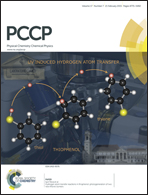NiO-decorated mesoporous TiO2 flowers for an improved photovoltaic dye sensitized solar cell†
Abstract
Reducing light-induced e–h recombination is important for a dye sensitized solar cell (DSSC); the p-type NiO component in TiO2–NiO nanoparticles was reported to significantly decrease charge recombination, but its photovoltaic efficiency remains below 4% owing to a small surface area. In this work, we used a one-pot self-assembly process to fabricate flower-like mesoporous TiO2 decorated by NiO oxides, employing a pluronic polymer P123 as a structure directing and pore forming agent. The flower-like porous TiO2–NiO nanoparticles (F–TiO2–NiO NPs), possessing a high BET surface of 130 m2 g−1, are first used as a photoanode in DSSCs. These hybrid nanoparticles, decorated with NiO islands, are beneficial for improving photocurrent by increasing dye absorption and suppressing electron–hole recombination. The optimized F–TiO2–NiO NP anode (10 μm thick) achieved a power conversion efficiency of 8.20%, which is 26% and 47% higher than pristine flower-like TiO2 and commercially available P25 anodes, respectively. This efficiency is the highest among the reported TiO2–NiO hybrid anodes.


 Please wait while we load your content...
Please wait while we load your content...